Ice. Fog. Our captain considers his options. Even our iron vessel, the Endeavor, seems to pause.
We are at the north entrance of the Lemaire Channel. For anyone who’s ever traveled to Antarctica, the Lemaire stands out.
Down the west side of the craggy and ice-caked Antarctic Peninsula, between the towering peaks of Booth Island and the mainland, is this narrow canal. When conditions are right, it is outright spectacular. But this morning, following a dawn wake-up call by our expedition leader (my boss) and even a proverbial drumroll the night before, weary passengers find cloud-obscured peaks and fog that dampens the grumble of the engine and the spirits of passengers and staff.
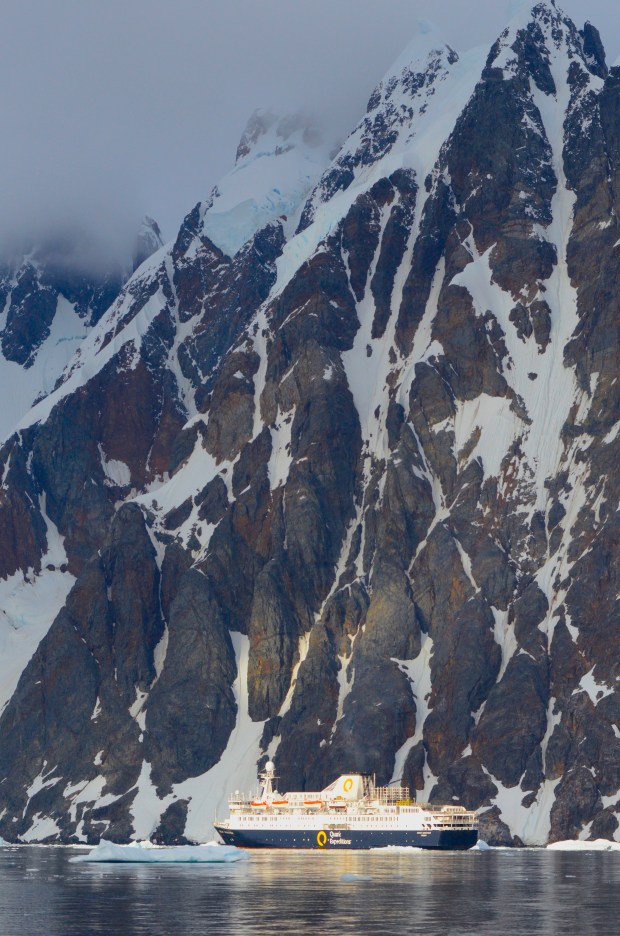
As we stand on the bow, the morning cold bites our faces and binocular- and camera-clutching fingers. Although our geologist attempts to dramatize the invisible on the intercom with talk of mountain formation, faults, and crashing tectonic plates, it can’t lift the weather. Passengers retire to the breakfast buffet.
We near the end, and the most spectacular points in the channel pass by unseen, the fog really sets in.
After navigating the canal, we are to reach the most southern point of our voyage, at 65 degrees 10 minutes south latitude, Petermann Island. And just when we are beginning to wonder whether there will be a morning excursion at all, postage stamps of blue sky and fog-framed peaks become barely visible.
The ship slows, and the rumble of the anchor chains echoes through the iron structure. Not a spot of cloud or smudge of fog remains. The land- and seascape lie before us. No wide-angle lens can encapsulate the panorama. Deep blue. Blinding white. A litter of icebergs down the straight. From this point on, the mountainous spine of the peninsula fades southward into the distance.
Soon Zodiac inflatable boats are being craned over the ship’s port and starboard. Guides like myself hop across rubber pontoons, turn keys, and rev cold engines.
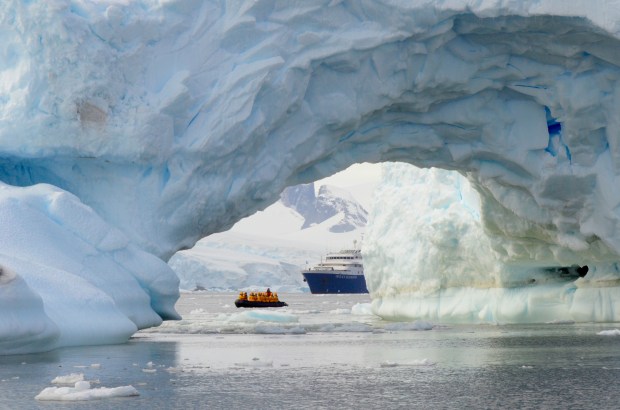
In minutes yellow parka-clad passengers file down the gangways to be picked up and ferried ashore. A typical day for an expedition ship in Antarctica involves at least two excursions, landing at any one of innumerable penguin colonies and cruising along the channel, navigating ice, and searching out seals and whales.
Nearing shore, we are met with the potent air of penguin guano. The snow is tinged pink from a summer of krill-hued droppings and snow algae. In Antarctica passengers learn to abide by a new traffic paradigm: Penguins have the right of way—always. Aside from maintaining the requisite 16 and-a-half foot distance, we frequently stop as they march ahead or contemplate their next move. Penguins may just be the most indecisive animals.

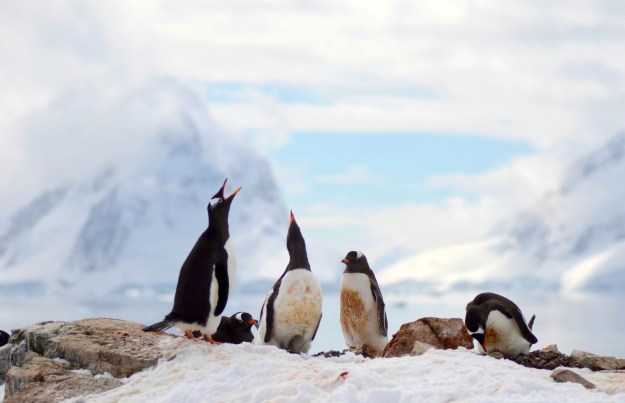
Petermann Island is home to the southernmost colony of Gentoo penguins, but also Adélies. Adélies are striking. Their all-black head, neck, and back are a stark backdrop to an alabaster belly and white-ringed eye. Like the emperor, they are some of the most cold-adapted penguins.
By this time, March, we are at the very end of the “penguin season.” The birds came ashore in October, the Antarctic spring, to build pebble nests. They laid eggs in November, chicks hatched in December, and now swarms of awkward chicks are replacing the last bits of their baby down with proper swimming feathers. The adolescentlike creatures are an odd mix of fluff and shine. Eventually the adults will return to the sea to recover from the trials of parenthood, but March is the height of swimming lessons. Young Adélies and Gentoos wreak havoc in the shallows, refining their skills through belly flops.

Petermann Island is important in the short history of exploration in Antarctica. The very bay we land in is where the Polar Gentleman—the French explorer Jean-Baptiste Charcot—froze his ship into the ice (on purpose) and overwintered. More than a century ago, on his second visit to Antarctica, he and his team charted and explored new areas of the peninsula. And they did so in style. Among Charcot’s provisions were bottles of rouge and Mumm Champagne.
He named this small bay Port Circumcision. An interesting choice, the name honors the day it was discovered, January 1, 1909, the Feast of the Circumcision (that odd one is named after the day of Christ’s, well, you get it).
On a rock wall opposite our landing site is a horizontal line etched into the surface, marking high tide, and beside it, “PP”: The Pourquoi-Pas? (Why Not?) was Charcot’s vessel.
Also in the small bay are the dilapidated remains of a 1950s Argentine refuge. They’re brick red with the blue, white, and yellow of the country’s flag. Argentina has numerous refuge huts, which partly serve as shelters and partly as territorial claim. Chile and Great Britain claim overlapping areas of the peninsula. Farther along are the crosses of three British scientists who died attempting to cross the sea ice.
1:00pm
After a full morning, passengers return to the ship. It pulls anchor and transits north. We hurriedly down ridiculous amounts of food, which I and my fellow guides follow with a much-needed espresso. The work’s fun but exhausting.
An hour later we’re dropping anchor near Pleneau Island in an area dubbed Iceberg Alley. From the height of the bridge, spires of ice extend infinitely. A counterclockwise current herds ice around the continent, so these bergs might be from the great ice shelves of the Weddell Sea to the east.
Once again Zodiacs are lowered. With full bellies, guides and passengers fill all 20 boats for two hours of exploration.
Astern of the ship is an unbelievable construction of ice. This one looks particularly unstable with rectangular columns at precarious angles and an enormous arch—a Roman ruin found in nature. It must be 40 meters high. However, 80 to 90 percent is below the surface, so its real size belies imagination. It’s probably grounded, dragging along the seabed, pulverizing everything in its path.
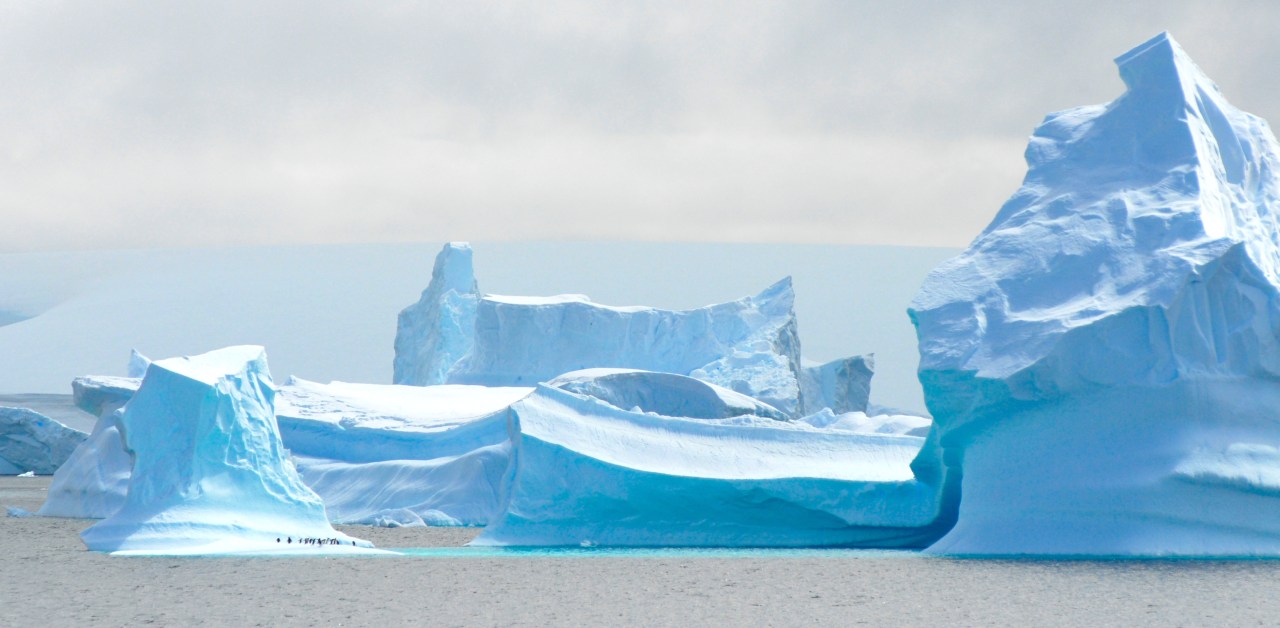
Beyond this immensity, white peaks poke out in the distance. I reassure disbelieving passengers that they are not mountains, but icebergs.
Pleneau Island is particularly rich in marine life, but two hours can easily be passed admiring the strange beauty and variety of the ice. The rounded and dimpled surfaces of some bergs mean they’ve rolled, revealing a surface carved by bubbles and seawater. Others have arches, stalagmites, or iridescent blue cracks and caves that glow. It often feels beyond scientific explanation, even for this biologist. Horizontal lines narrate the birth of these bergs, which began as part of the mighty glaciers surrounding us, built by eons of snow, accumulating layer after layer, year after year, before breaking away.
While the ice is endlessly fascinating, we still want to find the living and breathing. Soon we come across elongated pieces of black ice, then a sound like the deep vibration of an organ and an eruption of mist. The black ice is transformed into a pair of sleeping humpback whales.
I cut my engine, the exhaust dissipates, and I ask the passengers to put down their cameras and listen to the pulse of Antarctica: the jostle of brash ice and the deep, rhythmic exhalations of leviathans. Antarctic silence is not silence at all, but the exclusion of human interference and domination.
Soon we’re motoring softly among small bergs. A snow petrel, even whiter than the snow itself, with a charcoal beak and eyes, follows us, swinging from starboard to port and back, then hovering above.
Then, 328 feet away, we spy a gray elongated form on a pan of ice. The shape gives it away: an enormous head, slim neck, shoulder hump, and lithe silver body. It’s a leopard seal. We glide closer until we’re meters away. His large eye turns to us. He lifts his head and exhales noisily. He observes us. His wide smile with pink, krill-stained lips reminds me of the Joker. He’s a seal, but reptilian. Predators at the top of Antarctica’s food chain, leopard seals are endlessly curious and often playful, but they should always be treated with respect. A few burst Zodiacs are testament.
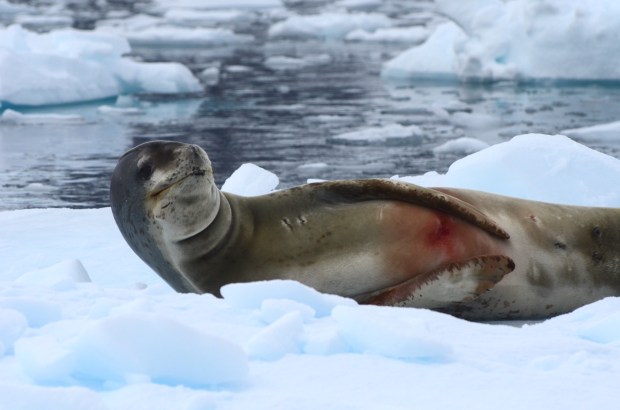
Soon enough his interest wanes. He looks away, laying his chin back on his pillow of ice.
It’s hard to believe, but two hours have just been eaten up by Antarctica, and we must head back for a tradition. The sun is shining, the water’s like glass—perfect for a dip.
4:30pm
Minutes after the last passengers are aboard our expedition leader announces what many have been waiting for: the polar plunge.
Passengers file down in white bathrobes, trembling nervously. To quell any worries, our doctor is on standby with a defibrillator. We cinch on belts, clip on ropes, and let them do all manner of cold-water entrances. Some cannonball, some spread-eagle, one backflips, others do painful belly flops, and a few hesitate, considering the ladder until onlookers on the upper deck egg them on with a countdown. After some less-than-graceful entries, contorted facial expressions, and surprising feats such as kissing bergs and swimming to the rope’s full extent, they all come back screaming, pink with cold and adrenaline. Some want to jump again, and others run to the heated pool on the back deck.

6:00
After the 121st and final plunger, we retract the gangways, the motor rumbles, and the anchor is pulled. From our southernmost point, we’re heading back north, through the Lemaire. Because Antarctic weather is forever changing, the morning cloud and fog are nonexistent and the channel is in its full glory. The 1,000-meter peaks are frosted in icing, absolutely windless, and the Endeavor is slicing through a mirror. Herds of crabeater seals slither off ice floes as we advance. And because it’s the end of the Antarctic summer, the sun is heading to the horizon at our stern, down the narrow channel, lighting up the mountainous peninsula. White snow turns orange, and the morning fog is a distant memory.
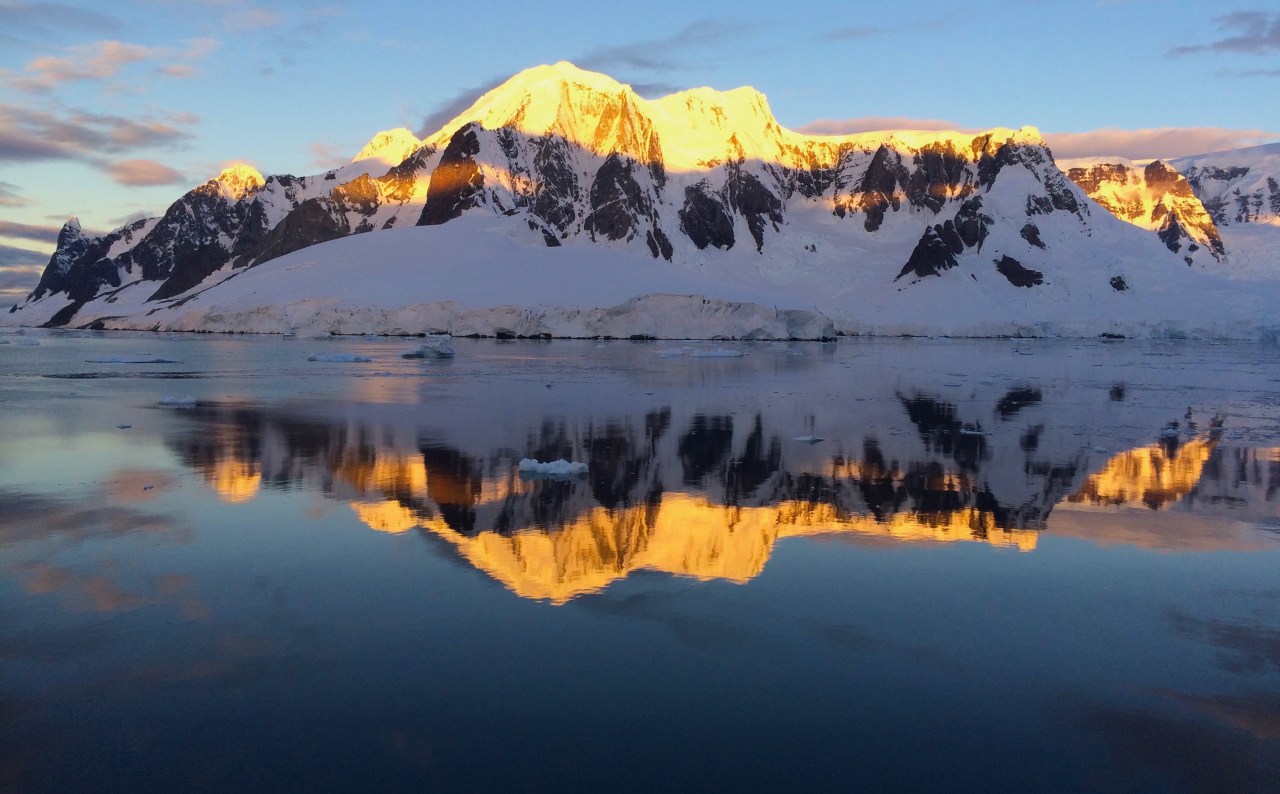
Nick Engelmann is an educator, biologist and writer. Bit by the polar bug, he went to Antarctica, and ever since has lived an “endless summer” in both polar regions, as a biologist and expedition guide. With a love for experience, he lives in endlessly-entertaining Argentina with his wife and daughter.